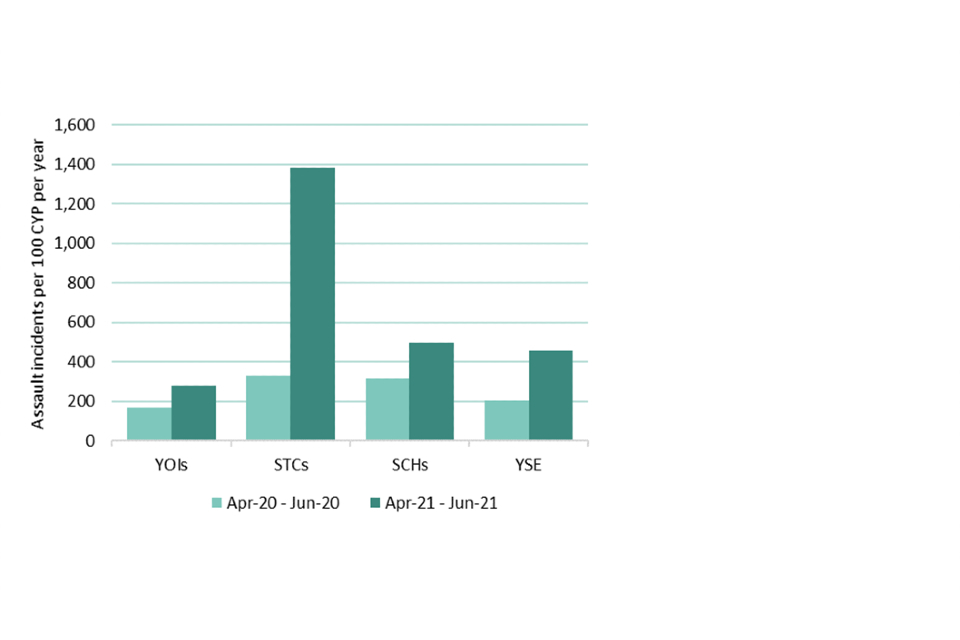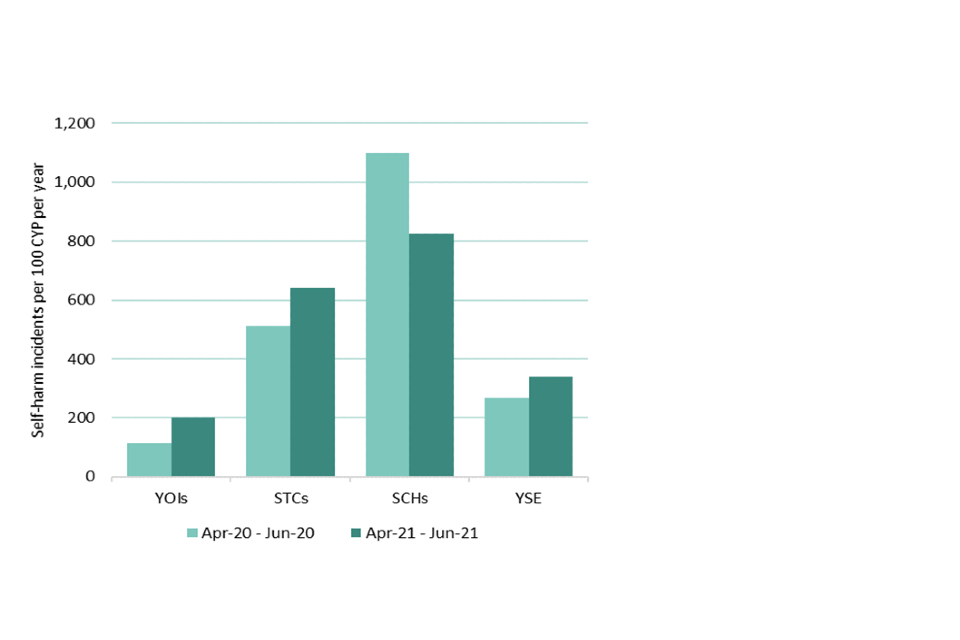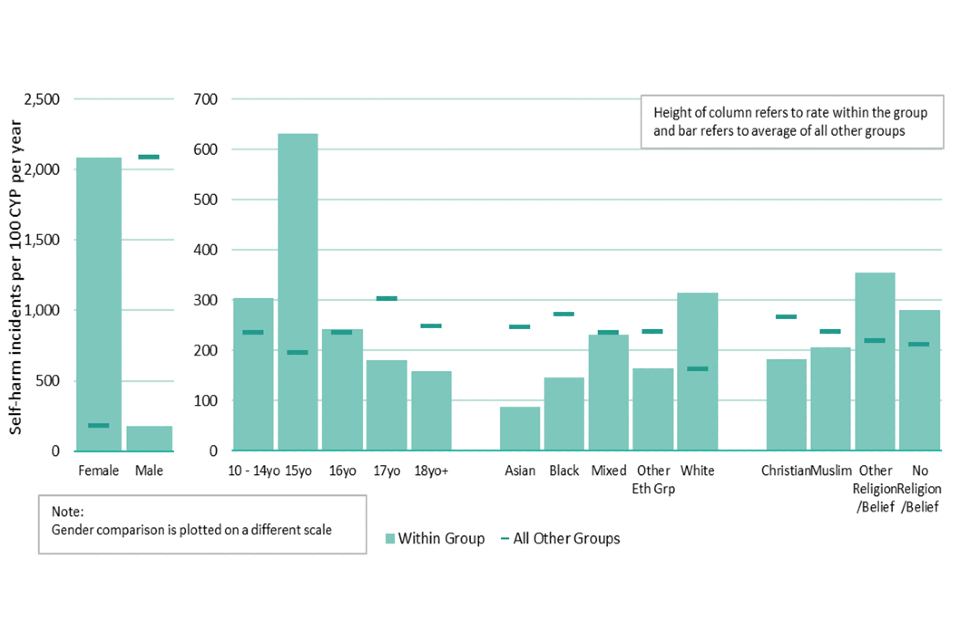Safety in the Children and Young People Secure Estate: Update to June 2021
Published 28 October 2021
Applies to England and Wales
Main Points
| 636 assault incidents Apr to Jun 2021, of which 42 were serious 394 different children and young people involved as assailants or fighters |
The annualised rate of assault incidents per 100 children and young people per year was 456 in the 3 months to 30 June 2021, an increase of 124% compared to the same period last year, which was during the first months of the Covid-19 pandemic. The number of individual children and young people involved in incidents as assailants or fighters increased 69% in the 3 months to 30 June 2021 compared to the same period last year, from 233 to 394. This is in the context of average population falling 24% over the same period. |
| 348 assault incidents on staff Apr to Jun 2021, of which 31 were serious | The annualised rate of assault incidents on staff per 100 children and young people per year was 250 in the 3 months to 30 June 2021, an increase of 80% compared to the same period last year, which was during the first months of the Covid-19 pandemic. |
| 473 Self-harm incidents Apr to Jun 2021 104 different children and young people self-harmed Apr to Jun 2021 |
The annualised rate of self-harming per 100 children and young people per year was 339 in the 3 months to 30 June 2021, an increase of 27% compared to the same period last year. The number of individual children and young people self-harming increased 20% in the 3 months to 30 June 2021 compared to the same period last year, from 87 to 104. This is in the context of average population falling 24% over the same period. |
| No deaths reported in the year to 30 Jun 2021 | The last death in the Children and Young People Secure Estate was in June 2019 |
The Safety in the Children and Young People Secure Estate Bulletin reports assault and self-harm incidents and deaths from April 2014 to June 2021. The latest information covers the period of the Covid-19 pandemic, which must be considered and accounted for in every aspect of the information presented and when comparing time periods.
1. Statistician’s Comment
These experimental statistics present data up until 30 June 2021 on incidents of assault, self-harm and death across each sector of the Children and Young People Secure Estate. From the outset of the pandemic the Youth Custody Service’s focus has been on meeting the needs of the children in custody and following physical distancing approaches. Inevitably by following the guidance to manage the spread of COVID-19 there has been an impact to activities delivered from March 2020. With less mixing of children and young people there was naturally a fall in the number of assaults. As activity restrictions started to lift and children mixed more, we saw an increase in the number of assaults. Throughout the experimental statistics the latest reporting quarter is compared to the same period last year, this is the first full quarter where the impact of COVID-19 control measures are evident in our statistics.
The Children and Young People Secure Estate has seen an increase in the rate of assault in comparison to the same period last year. The increase is primarily due to Secure Training Centres who continue to have the highest rate of incidents of assaults in comparison to the other sectors. The Secure Training Centres rate of assault was 1,384 per 100 CYP per year for the 3 months to 30 June 2021, this is an increase of 319% in comparison to the same period last year. Youth Offender Institutes and Secure Children’s Homes have also seen an increase in the rate of incidents of assault. Youth Offender Institutions hold the majority of the Children in the Young People Secure Estate population, and had the lowest rate of assault incidents in the 3 months to 30 June 2021 at 277 per 100 CYP per year, this was a 68% increase in comparison to the same period last year. Secure Children’s Homes hold the younger and often most complex Children and Young People within the Children and Young Peoples Secure Estate, and for the 3 months up to 30 June 2021 the rate of assault incidents was 498 per 100 CYP per year, which amounts to the smallest increase in assaults, at 58%, in comparison to the same period last year.
It is shown that the following groups have a higher rate of involvement in assaults, as an assailant or fighter; females, 15-year-olds, Black ethnic groups, and children of no religion.
There has been an increase in the rate of self-harm in comparison to the same period last year. The rate of self-harm differs across the three sectors and is typically influenced by a few individuals self-harming multiple times. The highest rates for this reporting period were recorded at SCHs at 824 per 100 CYP per year, this is an 25% reduction in comparison to the previous year. Across other sectors there was an increase in the rate of self-harm in comparison to the previous year. At Youth Offender Institutes the rate of self-harm was 201 incidents per 100 CYP per year over the quarter to 30 June 2021, which showed a 77% increase in comparison to the previous year. Secure Training Centres had a rate of 640 self-harm incidents per 100 CYP per year for this reporting period, which is a 25% increase in comparison to the previous year.
It is shown that the following groups have a high rate of self-harm: females, younger age groups (10-15-year-olds), White ethnic groups and children of religions other than Christianity or Islam or no religion.
No deaths of Children and Young People have been reported since June 2019.
2. Assaults: April 2014 to June 2021
Assault incident rate increased compared to same period last year.
In the 3 months to 30 June 2021, there were 636 assault incidents in the Children and Young People Secure Estate (CYPSE) involving 394 different children and young people (CYP) as assailants or fighters. The annualised rate of assault incidents was 456 per 100 CYP per year, an increase of 124% compared to the same period in 2020 when the rate was 204.
Assault incidents on staff rate increased compared to same period last year
In the 3 months to 30 June 2021, there were 348 incidents in the CYPSE where staff were assaulted. The annualised rate of assault incidents on staff was 250 per 100 CYP per year, an increase of 80% compared to the same period in 2020 when the rate was 139 per 100 CYP per year.
| Figure 1: Rate of assaults and fights by quarter - Apr 2014 to Mar 2018 | Figure 2: Rate of assault incidents per 100 CYP per year Apr 2019 to Jun 2021 |

The definition and counting rules of assaults changed from April 2019 (April 2018 for Young Offender Institutions (YOIs)) and hence no long-term trends are available and there was no estate-wide figure in 2018/19. Figures 1 and 2 illustrate the trends before and after the break respectively.
The rate of assault incidents fell substantially at the outset the Covid-19 pandemic. In the last full quarter prior to the pandemic (Oct to Dec 19), there were 995 assault incidents. For the reporting quarter April to June 2020 incidents fell to their lowest since the current assaults definition was introduced followed by quarter on quarter increases until the latest quarter where the rate of assault incidents have increased to just marginally below the level recorded in the last full quarter before the Covid-19 pandemic emerged.
The rate of incidents involving a staff assault also fell during the pandemic but is now above the pre-pandemic level. In the latest 3-months to 30 June 2021 there were 348 assault incidents on staff at a rate of 250 per 100 CYP per year. This is the highest rate since the change of definition in April 2019.
The rate of serious assaults in the 3-months to 30 June 2021 was 30 per 100 CYP per year, substantially higher than the same period a year earlier during the early months of the pandemic, when the rate was 11 per 100 CYP per year. Compared to last 3-months to 31 March 2021 however, the rate of serious assault incidents has fallen by 15%. Serious assault incidents on staff in the 3 months to 30 June 2021 have also increased substantially compared to the same period last year, by 139% from 9 to 22 per 100 CYP per year.
Over the 12 months to 30 June 2021 there were 903 unique CYP involved in an incident as either an assailant or fighter compared to 1,111 over the previous 12 months. During the 3 months to 30 June 2021 the year there were 394 unique assailants / fighters compared to 233 over the same period in 2020 despite the average population falling 24% between the two periods.
The number of unique victims among children and young people was 398 in the 12 months to 30 June 2021, down from 595 in previous 12 months. During the 3 months to 30 June 2021 there were 111 unique children and young people victims compared to 67 over the same period in 2020.
Figure 3: Rate of assault incidents per 100 CYP per year - Apr to Jun 20 and Apr to Jun 21

The rate of assault incidents during the 3-months to 30 June 2021 was higher across every sector of the CYPSE when compared to the same period last year. The size of the increase was highest in the STCs, recording rates 319% higher than 2020 and almost three times higher than any other sector. The smallest year-on-year increase in percentage terms was in the SCHs, which went up 58% although the lowest assault rates in the 3-months to 30 June 2021 were recorded in the YOIs. In the 3-months to 30 June 2021, the comparative rates across the sectors were 1,384 per 100 CYP per year in STCs, 498 per 100 CYP per year in SCHs and 277 in per 100 CYP per year in YOIs.
The rate of assaults on staff in the 3 months to 30 June 2021 was also highest within STCs at 996 per 100 CYP per year compared to 429 per 100 CYP per year in SCHs and 81 per 100 CYP per year in YOIs.
In terms of protected characteristics, the rates of involvement as an assailant or fighter over the 12 months to 30 June 2021 were higher than other groups for girls, at 1,311 per 100 CYP per year, for 15 year-olds; 1,118 per 100 CYP; for CYP from a Black background; 751 per 100 CYP, and CYP with no religion; 689 per 100 CYP.
The groups with the highest rate of involvement as a victim were 15-year-olds, at 125 per 100 CYP per year respectively and CYP from ‘other’ ethnic groups; 129 per 100 CYP per year.
Figure 4: Rate of assailant / fighters by protected characteristic – Jul 20 to Jun 21

3. Self-Harm: April 2014 to June 2021
Self-harm incidents increasing and up on the same period last year
In the 3 months to 30 June 2021 there were 473 incidents of self-harm involving 104 different CYP. The annualised rate was 339 incidents per 100 CYP per year, an increase of 27% compared to the same period last year.
Figure 5: Annualised rate of self-harm incidents per 100 children and young people in custody

The rate of self-harm incidents fell substantially during the first 9 months of the Covid-19 pandemic but has increased in each of the latest two quarters. The rate of self-harm for the latest 3 months to 30 June 2021 was the highest it has been since at least 2014. The rate increased by 65% between the 3 months ending 31 March 2021 and the 3 months ending 30 June 2021. Across the entire year to 30 June 2021 the rate was 237 per 100 CYP.
The number of individuals self-harming over the 12 months ending 30 June 2021 was 263 compared to 347 over the preceding 12 months. The number of individual children and young people self-harming in the latest 3 months was 104, compared to 87 individual children and young people who self-harmed in the 3 months ending 30 June 2020.
Figure 6: Rate of self-harm incidents per 100 CYP per year - Apr to Jun 20 and Apr to Jun 21

Rates of self-harm differ substantially across the three sectors of the CYPSE. The highest rates are generally recorded in the SCHs, followed by the STCs with the lowest rates in YOIs. This is again the case in the 3 months to 30 June 2021 although the rate within SCHs has fallen compared to the same period last year. SCHs recorded 824 incidents per 100 CYP per year in the 3 months to 30 June 2021, down 25% on the previous year, STCs recorded 640 per 100 CYP per year (up 25%) and YOIs recorded 201 per 100 CYP per year (up 77%).
The rate of self-harm incidents can be influenced by a few individuals self-harming multiple times, so it is important to consider the number of different individuals self-harming as well as the overall count of incidents. The highest rate of unique CYP self-harming over the quarter to 30 June 2021 was in STCs (41 different self-harmers from an average population of 77[footnote 1]), followed by SCHs (22 different self-harmers from an average population of 70) and then YOIs (43 different self-harmers from an average population of 413)
Over the 12 months to 30 June 2021, a total of 392 self-harm incidents resulted in an injury requiring some treatment, 27% of the total, and 59, 4% required hospital attendance.
The number of girls in the CYPSE is low (an average of 18 over the 12 months to 30 June 2021), but they do include some of the most vulnerable children and young people. The rate of self-harm among girls was 2,086 incidents per 100 per year, compared to 181 per 100 boys per year. Each of the girls who self-harmed also did so on average 14 times per year.
Self-harm was most common among 15-year-olds (631 incidents per 100). White children (316 per 100) in comparison to all other groups combined (162 per 100). If grouped together, children who declared a religion other than Christian or Islam self-harmed at a higher rate (355 per 100) than all other groups (218 per 100). These differences across protected characteristics are shown in figure 7.
Figure 7: Rate of self-harm incidents by protected characteristic – Jul 20 to Jun 21

4. Deaths: April 2014 to June 2021
No deaths were reported in the Youth Children and Young People Secure Estate in the 12 months ending 30 June 2021 and one in the preceding 12 months
Deaths of children and young people are fortunately rare and there were no deaths in the 12 months ending 31 March 2021. Since April 2014 there have been three deaths of children and young people within the CYPSE.
- Two at Cookham Wood YOI in July 2015 and June 2019
- One at Hillside SCH in February 2017
- Each of these deaths was due to natural causes
Further Information
Accompanying files
As well as this bulletin, the following products are published as part of this release:
- A guide providing further information on how the data are collected and processed, as well as an assessment of data quality. The revisions policy, other statistical issues and a glossary of terms used are also covered in the guide.
- A set of summary tables covering both the latest quarter and annual summaries of the data back to 2014/15.
Experimental Statistics status
These statistics are designated as Experimental Statistics. This is because they are a development from Safety in Custody Statistics with the statistics mirroring the information presented in Safety in Custody and reflecting the requirements of the entire Children and Young People Secure Estate. They are undergoing evaluation and may be subject to further development based on user feedback.
Safety in Custody have been designated as National Statistics by the United Kingdom Statistics Authority signifying that they comply with the Code of Practice for Official Statistics. The Safety in the Children and Young People Secure Estate Bulletin does not have that designation but nevertheless complies with the Code of Practice whenever possible.
It is the intention to seek feedback from users of the statistics and groups with an interest in youth custody to assess whether the presentation and breadth of the information presented is sufficient and useful. This feedback will inform how and when to remove the experimental statistics designation.
Contact points
Press enquiries should be directed to the Ministry of Justice press office:
Tel: 020 3334 3536
Email: newsdesk@justice.gov.uk
Other enquiries about these statistics should be directed to:
Katherine Tatlock
Youth Custody Service
HM Prison and Probation Service
Southern House
Wellesley Grove
Croydon
CR0 1XG
Email: statistics.enquiries@justice.gov.uk
Next update: 27 January 2022
URL: https://www.gov.uk/government/collections/youth-justice-statistics#youth-secure-estate-statistics
Alternative formats are available on request from statistics.enquiries@justice.gov.uk
© Crown copyright. Produced by the Ministry of Justice.
-
Through June and July 2021, children and young people were removed from Rainsbrook STC and no new placements were made ↩
